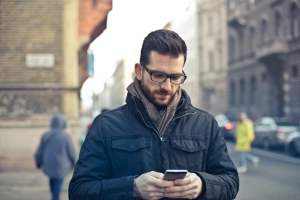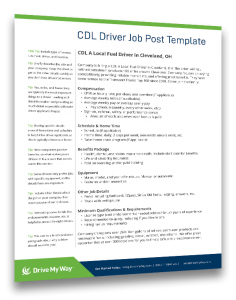
The Benefits of Truck Driving Jobs for Military Veterans
Trucking jobs offer a host of advantages, particularly for military veterans seeking flexibility with their hours. After serving their country, many veteran truck drivers can relish weekends, nights, or days off to spend quality time with their loved ones. What’s more, some drivers can take their family or pets along for the ride, which is especially thrilling for kids.
Apart from spending time with family, trucking jobs for military veterans enable drivers to explore some of the most stunning parts of the country, including snow-capped mountains, major cities, and the iconic Iowa 80 mega truck stop.
CDL jobs are an excellent choice for veterans as they typically offer good salaries, sign-on bonuses, job security, and various other benefits. Moreover, they provide ample opportunities for career advancement. Among the many job options available to veterans after their military service, CDL jobs are one of the best for both them and their families.
In addition to the undeniable benefits of a career in truck driving for veterans, there is another crucial aspect to consider. The transportation of goods across the country is an essential aspect of our economy. Without truck drivers, this would not be possible. Much like our nation depends on the military for security and protection, we also depend on truck drivers to keep our economy thriving. It is gratifying to know that you play a crucial role in the functioning of this entire country.
Why Veterans Should Consider a Truck Driving Career
Military veterans have a natural edge when it comes to truck driving careers. The skills learned in the military, across various branches and roles, can be effortlessly applied to truck driving. With a successful military career, you most likely already have the traits that make for a great commercial truck driver. Don’t be surprised to realize how much potential you have in this line of work.
Work Environment
Truck driving careers offer a unique blend of independence and camaraderie. Drivers enjoy the freedom to choose their own hours and income while also being supported by their carrier and a tight-knit community of fellow drivers. With the potential for high earnings, a career in truck driving is an attractive option for veterans seeking a fulfilling and flexible career path.
Skills and Requirements
Truck driving demands a thorough understanding and adherence to rigid government safety regulations and company policies, which include mandatory rest periods and defensive driving practices. Adhering to these guidelines is essential for truck drivers to enjoy a long, prosperous career. Most veterans already possess the fundamental skills that trucking companies seek during intensive training and field experience, such as situational awareness, dependability, leadership, management, and teamwork. Furthermore, disciplined and committed military veterans won’t have any trouble acquiring specific driving skills through CDL training and driver orientation.
Waive the skills test!
Veterans with significant military driving experience may be eligible for a skills test waiver, and those with a CDL from their time in the military can start their driving career with a higher pay rate.
Job Security
Veterans seeking job security, a steady income, and retirement options should consider a truck driving career. Your talents are in high demand. It’s an excellent career transition option for retired veterans with the added benefit of company benefits.
The trucking industry needs skilled and dedicated drivers. Fortunately, military veterans possess the qualities and capabilities that make them ideal candidates for a successful career in truck driving. With the added benefits and support available to veterans, this path offers a promising and fulfilling option for those seeking a new direction.
Ultimate Guide to Truck Driver Recruiting
Current ways of recruiting truck drivers just don’t work anymore. That’s because recruiting isn’t a transaction. This ultimate guide helps carriers recruit for retention.




 As we mentioned, drivers are already speaking to each other about your carrier. Your company already has a reputation, and you can’t override it by a referral program. Either your drivers believe you have a strong company and culture that
As we mentioned, drivers are already speaking to each other about your carrier. Your company already has a reputation, and you can’t override it by a referral program. Either your drivers believe you have a strong company and culture that  Many companies use incentives to nudge drivers into making referrals. Most of these incentives are monetary rewards, although they don’t have to be. As we learned in high school economics class, incentives matter.
Many companies use incentives to nudge drivers into making referrals. Most of these incentives are monetary rewards, although they don’t have to be. As we learned in high school economics class, incentives matter. It’s easy to think of referral programs as a waste of money if you haven’t used them before or measured their impact. Try to think of driver referrals as an investment into your
It’s easy to think of referral programs as a waste of money if you haven’t used them before or measured their impact. Try to think of driver referrals as an investment into your  Comprehensive CDL Recruitment Solutions
Comprehensive CDL Recruitment Solutions
 On average, team drivers are more experienced drivers and seasoned negotiators than most solo drivers, so recruiting them to your organization may take a bit more than what you’re used to as a recruiter. If you’re a recruiter who’s recently been tasked with hiring team drivers, here are 4 tips that can help you along the way.
On average, team drivers are more experienced drivers and seasoned negotiators than most solo drivers, so recruiting them to your organization may take a bit more than what you’re used to as a recruiter. If you’re a recruiter who’s recently been tasked with hiring team drivers, here are 4 tips that can help you along the way.  Team drivers on average make more than their solo counterparts. If your carrier is serious about hiring qualified team drivers, you’ll most likely have to up their pay from what you’d give a solo driver.
Team drivers on average make more than their solo counterparts. If your carrier is serious about hiring qualified team drivers, you’ll most likely have to up their pay from what you’d give a solo driver.  Many established team drivers are couples. This makes sense, since if you had to choose to live in a confined space with anyone for days, maybe weeks at a time, it would probably be your significant other.
Many established team drivers are couples. This makes sense, since if you had to choose to live in a confined space with anyone for days, maybe weeks at a time, it would probably be your significant other. 
 We talked to CDL Driver, Angela who hauls with her husband Larry and she told us that the thing he likes the least about team driving is not being able to get a good night’s sleep while the truck is moving. This is a common complaint for a lot of team drivers. In fact, it’s not just issues sleeping, it’s an issue of comfort overall.
We talked to CDL Driver, Angela who hauls with her husband Larry and she told us that the thing he likes the least about team driving is not being able to get a good night’s sleep while the truck is moving. This is a common complaint for a lot of team drivers. In fact, it’s not just issues sleeping, it’s an issue of comfort overall.  We’ve talked before about the power of driver testimonials in the trucking industry. While they’re great for recruiting solo drivers, they’re even better for hiring team drivers.
We’ve talked before about the power of driver testimonials in the trucking industry. While they’re great for recruiting solo drivers, they’re even better for hiring team drivers. 

 Slowly but surely, companies are re-opening and finding a new normal. The widespread shutdowns due to COVID-19 will continue to ease, but the effects of the pandemic are likely to linger for far longer. With millions of Americans becoming remote workers overnight, virtual recruiting and onboarding have become the norm for many companies. Even as restrictions on in-person work environments are relaxed, prepare to manage your
Slowly but surely, companies are re-opening and finding a new normal. The widespread shutdowns due to COVID-19 will continue to ease, but the effects of the pandemic are likely to linger for far longer. With millions of Americans becoming remote workers overnight, virtual recruiting and onboarding have become the norm for many companies. Even as restrictions on in-person work environments are relaxed, prepare to manage your 

 From the moment of onboarding, driver recruiters should be trained to look at recruiting as a long game. Explicitly tell recruiters that the company’s mission is to
From the moment of onboarding, driver recruiters should be trained to look at recruiting as a long game. Explicitly tell recruiters that the company’s mission is to 
 If you’re dealing with high application abandonment, try putting yourself in a driver’s shoes. Most drivers don’t want to spend their limited free time filling out lengthy and complex applications. In fact, this is usually
If you’re dealing with high application abandonment, try putting yourself in a driver’s shoes. Most drivers don’t want to spend their limited free time filling out lengthy and complex applications. In fact, this is usually  Since drivers spend most of their time on the road, they mainly search for and apply to jobs using their smartphones. In this mobile-first world, recruiters and fleet managers need to make sure they’re able to communicate and interface with drivers this way. Otherwise, you risk a large number of drivers abandoning your application.
Since drivers spend most of their time on the road, they mainly search for and apply to jobs using their smartphones. In this mobile-first world, recruiters and fleet managers need to make sure they’re able to communicate and interface with drivers this way. Otherwise, you risk a large number of drivers abandoning your application. While you, as a recruiter can create what you think is the most efficient, painless, and all-around great application experience, you won’t really know how it is until drivers start applying. Even when they do start, it can be hard to gauge what’s working and what’s not since gathering data around job application abandonment can prove to be difficult.
While you, as a recruiter can create what you think is the most efficient, painless, and all-around great application experience, you won’t really know how it is until drivers start applying. Even when they do start, it can be hard to gauge what’s working and what’s not since gathering data around job application abandonment can prove to be difficult.


 When speaking with driver candidates, be sure you’re an expert on your company and the particulars of the job. Know what the day-to-day will look like and give honest answers. Don’t sugarcoat things if you know that your company might not have the world’s best benefits or if the pay might not be at the top of the scale.
When speaking with driver candidates, be sure you’re an expert on your company and the particulars of the job. Know what the day-to-day will look like and give honest answers. Don’t sugarcoat things if you know that your company might not have the world’s best benefits or if the pay might not be at the top of the scale.  This may sound obvious, but you’d be surprised how many recruiting departments lack a cohesive plan for how to bring drivers into their organization. While each hiring plan will vary from carrier to carrier, all of them should have two things in common. They should be measurable and repeatable.
This may sound obvious, but you’d be surprised how many recruiting departments lack a cohesive plan for how to bring drivers into their organization. While each hiring plan will vary from carrier to carrier, all of them should have two things in common. They should be measurable and repeatable. The first goal for any truck driver recruiter is to bring in the best drivers to their organization. The second is to bring those drivers in quickly and efficiently. We’ve talked about how important it is to keep drivers moving through your
The first goal for any truck driver recruiter is to bring in the best drivers to their organization. The second is to bring those drivers in quickly and efficiently. We’ve talked about how important it is to keep drivers moving through your  Your recruiting team only has so many hours in the day, and sometimes those hours can get allocated to tedious, clerical tasks that aren’t directly related to hiring drivers. Using recruitment automation technology helps with those tasks so
Your recruiting team only has so many hours in the day, and sometimes those hours can get allocated to tedious, clerical tasks that aren’t directly related to hiring drivers. Using recruitment automation technology helps with those tasks so  Once you have a steady flow of driver applicants for your open positions, what’s next?
Once you have a steady flow of driver applicants for your open positions, what’s next? We know that recruitment automation can help you find driver candidates more quickly. But what about after you find them? Where can you continue to automate processes with your employees?
We know that recruitment automation can help you find driver candidates more quickly. But what about after you find them? Where can you continue to automate processes with your employees?
 1. Hiring Drivers
1. Hiring Drivers
 Just as you are sacrificing time to attend these events, so are drivers. It’s fair to say, most drivers have reduced availability to attend events like these, as they are often on the road with limited hours.
Just as you are sacrificing time to attend these events, so are drivers. It’s fair to say, most drivers have reduced availability to attend events like these, as they are often on the road with limited hours. Megan Andrews is a Customer Success Manager at Drive My Way. She worked for a National Recruiting Agency prior to joining the Drive My Way Team in early 2021. During her time with her previous employer, she worked with small mom and pop companies up to Fortune 500 companies to find the best talent across all industries.
Megan Andrews is a Customer Success Manager at Drive My Way. She worked for a National Recruiting Agency prior to joining the Drive My Way Team in early 2021. During her time with her previous employer, she worked with small mom and pop companies up to Fortune 500 companies to find the best talent across all industries.  Almost every carrier has some sort of Facebook presence by now. Whether that Facebook presence is actively helping you reach drivers is the bigger question.
Almost every carrier has some sort of Facebook presence by now. Whether that Facebook presence is actively helping you reach drivers is the bigger question. 
